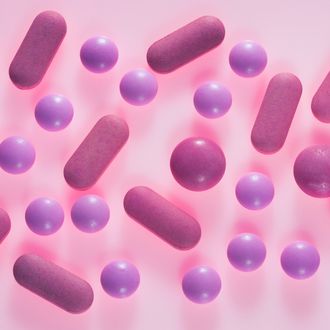
Addyi, or what is most often (if inaccurately) referred to as “female Viagra,” hit the market earlier this month. As we’ve reported, it probably doesn’t do much. And yet its introduction to the market is significant regardless, says Thea Cacchioni, a sex researcher at the University of Victoria and the author of the new book Big Pharma, Women, and the Labour of Love. Now that women have their very own drug to treat sexual dysfunction, it heralds the start of a “sexual pharmaceutical era,” Cacchioni writes.
This really began, of course, in the 1990s, with Viagra. Since then the race has been on to find a female version of the drug, a race Sprout Pharmaceuticals won this summer with flibanserin (the generic name for the drug), despite the evidence showing that it hardly works better than a placebo. In her book, Cacchioni — who testified before the FDA against flibanserin — explores the overlooked side effects of the pharmaceutical industry’s “growing influence over definitions of health and illness,” specifically in a sexual context.
Cacchioni recently spoke with Science of Us about her book — here are the highlights of that conversation.
You might call this current era a time of “re-medicalization” of sex. Around the late 1800s, Cacchioni explains, was the first time in recent history that sexuality was considered a medical problem. “That’s when a lot of doctors got involved trying to label and diagnose sexual norms and deviances,” she said to Science of Us. “And then around the 1970s — at the same time as the sexual revolution, second-wave feminism, the birth of LGBT rights — around that period a lot of things were de-medicalized.”
During this period, homosexuality was taken out of the Diagnostic and Statistical Manual of Mental Disorders; the same goes for the term frigidity, which had up until then been used in the medical literature to describe low sexual desire in women. “But all of a sudden, in the ‘90s with Viagra, there’s this kind of re-medicalization,” Cacchioni said. “A whole market was made out of what they called erectile dysfunction. Before it was called impotence and had more of a psychological connotation.” Likewise, when it came time to search for the female version of the drug, pharmaceutical companies “weren’t going to bring back frigidity — that wouldn’t be a smart marketing move,” she continued. “They were going to find a more neutral term, which is female sexual dysfunction.”
There is some potentially shady business behind the history of the term “female sexual dysfunction” in the scientific literature. That phrase is most often tied to a 1999 paper in the respected and widely read medical journal JAMA, in which a trio of physicians argued that sexual dysfunction was an “important public-health concern,” and particularly for women. Their survey of more than 3,000 Americans suggested that a whopping 43 percent of women had experienced sexual dysfunction — though, as Cachionni points out, this may be a little misleading.
“Among other things, the survey asked a series of questions about whether women had experienced any sexual difficulties in the past year — for example, if they lacked interest in sex, felt anxious about their sexual performance, had trouble with lubrication, failed to orgasm, came to orgasm too quickly, or experienced pain with intercourse,” she writes. “The 43 percent statistic came from assuming that an answer of ‘yes’ to any one of these questions was grounds for categorizing the respondent as having [female sexual dysfunction].” Beyond that, two of the authors of that paper turned out to have financial ties to Pfizer, the drug company that manufactures Viagra.
As a side effect, heterosexual women feel like it’s on them to fix the problem of bad sex. When Cacchioni started her research, Addyi didn’t yet exist. And so she was curious: What were women who would be the target demographic for the drug doing without it? The answers, as you might expect, were all over the place. Some women went to sex therapists or their primary doctors, others went to naturopaths, and many women hit the sex-toy shops. But in her interviews, Cacchioni did identify one thing that most of the women had in common. “What I came to realize on talking to these women is … how much pressure they felt to work on their sex lives — and especially them as individuals, as opposed to as a couple,” she said.
In the book, she calls this the “labour of love.” It’s a phrase she also uses as part of the book’s title, and beyond her interviews with women, Cacchioni has studied this in the popular culture. “Women are still two thirds of the purchasers of self-help guides in the category of ‘relationship’ and ‘family’ and more likely to seek professional advice for anything ‘health’ related, as sex is now considered to be,” she writes. “This kind of advice exhorts women to take care of both their own sexual problems and their partner’s.” The burden of fixing bad (heterosexual) sex is usually placed solely on heterosexual women. “It was never really a question of ’Will my partner try harder to please me or try new things?’” Cacchioni said. “It was really like it was an individual problem.”




